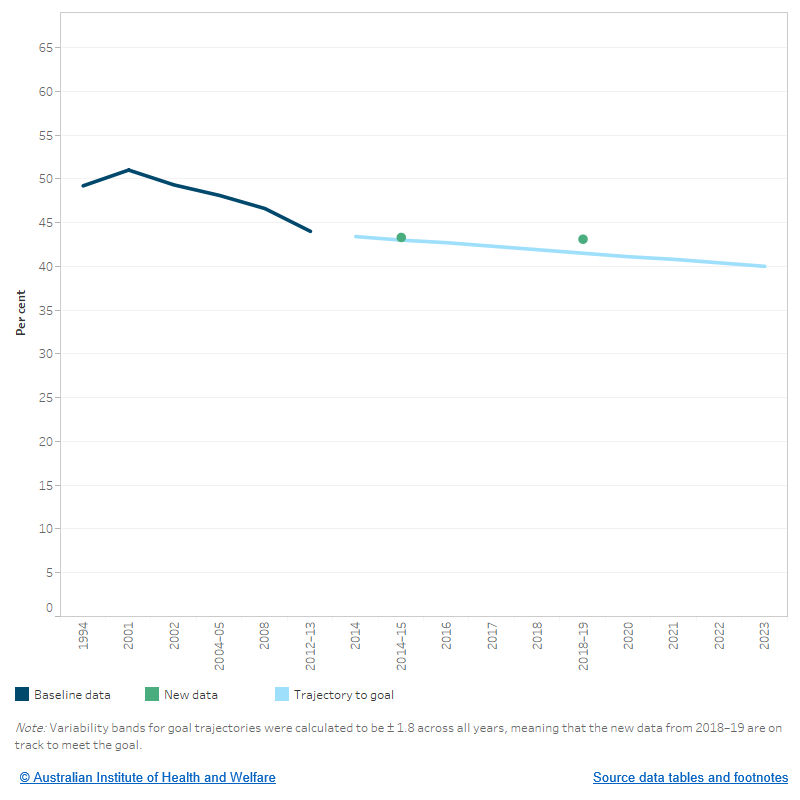Goal 12: Current smoking – people aged 18 and over
This indicator reports on the age-standardised proportion of Aboriginal and Torres Strait Islander people aged 18 and over who smoke tobacco. The goal for this indicator is 40% by 2023.
Why is it important?
Smoking is the leading preventable cause of disease and death in Australia. In the Australian Burden of Disease Study 2018, tobacco smoking was estimated to contribute 12% of the disease burden among Indigenous Australians (AIHW 2021).
What data are available?
Data for this indicator were sourced from the ABS National Aboriginal and Torres Strait Islander Health surveys and the National Aboriginal and Torres Strait Islander Social surveys.
What do the data show?
There is no new data available since the last update, however the most recent assessment showed that progress towards the goal was on track.
- The age-standardised rate of Indigenous Australians aged 18 and over who reported smoking tobacco in 2018–19 was 43%, which was similar to the trajectory point of 42% required to meet the goal, taking into account sampling error associated with the survey data.
Based on age-standardised rates:
- The proportion decreased between 2002 and 2014–15 (from 49% to 43%).
- The rate remained stable between 2014–15 and 2018–19 at around 43%.
- In 2018–19, the proportion (43.1%) was slightly above the trajectory point required (41.5%). However, taking into account sampling error associated with the survey data, the goal can be considered on track.
In 2018–19, based on age-standardised rates:
- 43% of Indigenous Australians aged 18 and over reported smoking tobacco.
- Among those aged 18 and over, Indigenous Australians were more likely than non-Indigenous Australians to smoke tobacco—age-standardised rates of 43% and 15%, respectively.
- Across all age groups, the proportion of Indigenous adults who were current smokers was higher in Remote than Non-remote areas.
Figure 12.1: Rate of Aboriginal and Torres Strait Islander people aged 18 and over who report being current smokers (age-standardised)
This figure shows the baseline data from 1994 to 2012–13, trajectory to the goal from 2014 to 2023. New data from 2014 to 2018 for the proportion of Indigenous Australians aged 18 and over who are current smokers are plotted. New data show that in 2018–19, 43.1% of Indigenous Australians aged 18+ were current smokers.

Figure 12.2: Australians aged 18 and over who reported being current smokers, by Indigenous status, sex and age group, 2018–19
The figure shows the proportions of Australians aged 18 and over who are current smokers, by age group and Indigenous status. It shows that Indigenous Australians are more likely than non-Indigenous Australians to smoke among all age groups. Among Indigenous Australians, the rate of smoking was highest among those aged 35–44 (49.9%).

Figure 12.3: Aboriginal and Torres Strait Islander people aged 18 and over who reported being current smokers, by age group and remoteness, 2018–19
The figure shows that Indigenous youth are more likely to smoke in remote areas than in non-remote areas across all age groups. The largest remoteness difference was among those aged 18–24 (34.5% in non-remote areas, and 65.2% in remote areas).

Reference
AIHW (Australian Institute of Health and Welfare) 2021. Australian Burden of Disease Study 2018: key findings for Aboriginal and Torres Strait Islander people. Cat. no. BOD 28. Canberra: AIHW. Viewed 8 October 2021.


